As many of you may know, I am an endless complaining machine that cannot be satisfied even by the most magnificent of creations anywhere to be found. This debilitating curse manifests itself most thoroughly when it comes to high-tech travel gear, much of which is cartoonishly ruined by moronic designers who seem to have absolutely no idea that even the smallest of modifications could vastly improve their creations by several orders of magnitude.
I have no earthly idea how they’re able to screw things up so frequently, and many a strongly-worded-letter has departed from my desk, only to be cursorily answered or summarily ignored by the willfully foolish recipients whose job descriptions apparently do not include “making things not suck.”
So I’ll just complain here instead.

Backpack manufacturers make a massive variety of packs, churning out the designs every single year, with a billion different sizes, colors, configurations, and everything else. You’d think they’d provide enough variety to satiate the needs of even the most discerning of pack enthusiasts. But nay. Somehow they still manage to screw things up all over the place.
Now I’ll readily admit that in many cases, my subjective needs are not universally ideal; travel-specific packs require a somewhat different set of features compared to hiking packs, and the comparative rarity of travel packs means I quite often have to make do with a hiking pack, which is a bit like giving dog food to a crocodile. He’ll eat it, sure, but it’s still dumb.
But they’re not getting away so easily. Nay! I am here to complain, and complain I shall.
The following problems consist exclusively of design flaws that are not subjectively unsuitable for my purposes, but are just objectively stupid. They’re wrong. Plain and simple. And people need to stop doing them.
Let’s begin.
Backpack design flaws that need to stop immediately
1. Stupidly tiny “water bottle” pockets
I have absolutely no idea how this trend started. I think it has something to do with the popularity of hydration bladders, and backpack manufacturers figured that’s all they had to worry about. If everybody just has a hydration bladder, they won’t be storing a water bottle in a side pocket.
But not everybody has a hydration bladder. In fact I’d be willing to bet that more people have water bottles than hydration bladders, and they need a place to put them goddammit. Where the hell can they go besides the damn side pocket?!?! Not in the main compartment of the pack, surely. Not only is it a stupid hassle to take it out whenever you need a sip of water, but if there’s a leak of any kind, all of a sudden your day is ruined.
But I see backpacks all over the place…seemingly the majority of them…that have extraordinarily small side pockets with no ability to expand whatsoever. Which means they’ll be flat against the wall of the pack itself with a round water bottle trying to find its way inside! You’re literally stuck trying to fit a round object into a flat compartment. Do they even bother trying to fit any of those bottles that are sold in the same stores into the side pockets before shipping the product out the door?!?!
But they even issue promotional photos displaying a water bottle fitting into the pocket. Quite often the pack itself is only partially filled, meaning the water bottle dug into the empty space of the main compartment, meaning if the bag were full, you’d be out of luck.
And it’s not like they can’t handle solving this problem. It’s actually stupidly easy. All they have to do is:
- Use stretchy fabric
- Fold the fabric
In fact you only really need to do one or the other. In either case, the fabric will lay flat when the pocket is empty, and pop open when you stuff a water bottle inside. It’s literally that simple. And even if you don’t need to fit a water bottle in there, it’s still objectively superior anyway.
Behold:
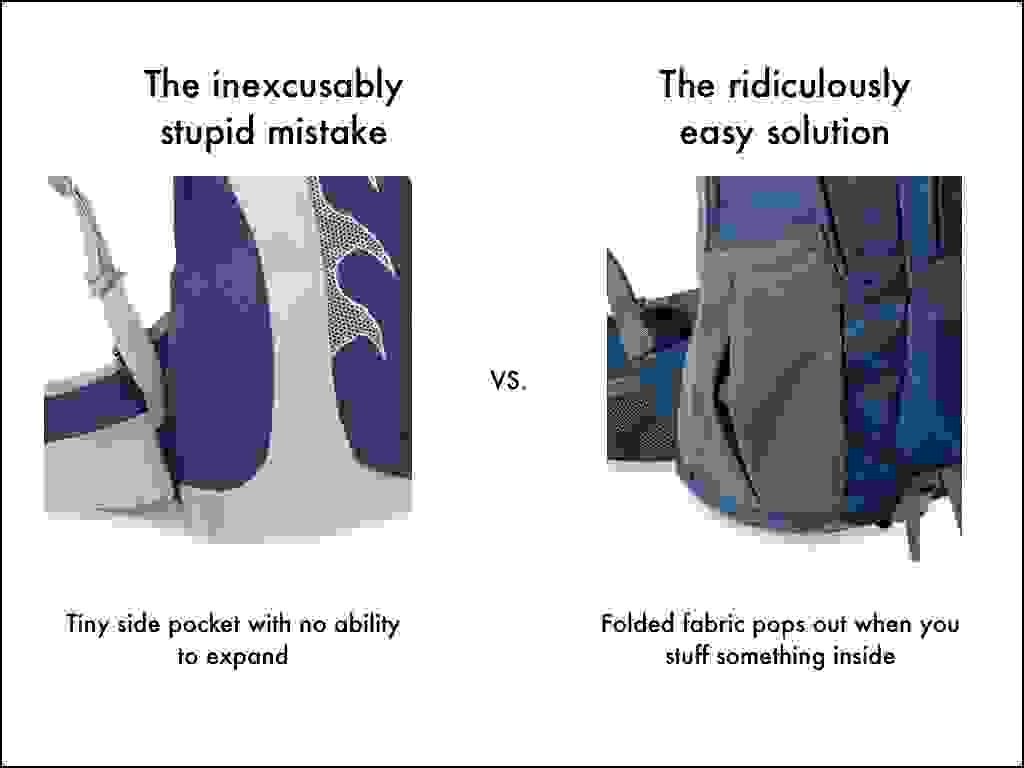
I will never stop complaining about this, because it’s the most annoying thing in the world to me. I shouldn’t have to figure water bottle location into pack purchase decision making. They should just all be good.
2. Compression straps that cover the side pockets
So it’s one thing to make a side pocket so stupidly small that you can’t use it. But it’s another thing entirely to have a perfectly good pocket and lash something right over the top.
They’re called “compression” straps, and you have to pull them tightly to compress the pack. And you know what happens when you pull a strap tightly over a pocket? You can’t use the pocket anymore. You literally have to decide whether you’re going to use the pocket, or the strap, but not both. Or at least, not very well. The strap won’t be doing much in the way of compression if it’s loose enough to access the pocket itself, and thus is pointless.
The worst offense is when not one but two straps go right over the side pocket. On packs so small that they don’t need the double strap anyway!
In some cases, these straps can actually be routed behind the side pocket, so they won’t get in the way of things. But the fact that certain companies allow this option only on some of their packs is incredibly annoying. It’s also not even the best way to solve the problem.
Once again, a variety of solutions exist. Here’s the easiest one:
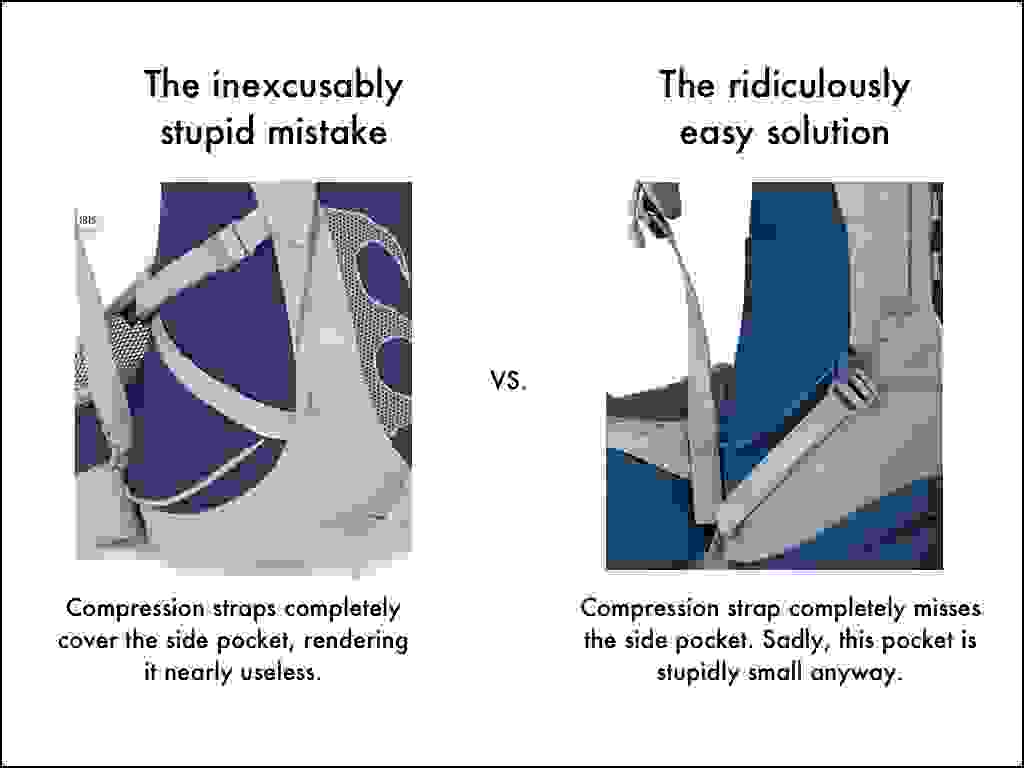
You can cut them off, but why don’t they just not do stupid things to begin with?!?!
3. Filthy dirty lie “panel” loading
This is mainly a vocabulary problem. Allow me to elaborate:
Backpacks come in a few varieties: Top loaders, which consist of giant cylindrical main compartments with a lid on the top; and panel loaders, which have a large, horseshoe-shaped zipper which allows the entire pack to be opened up like a suitcase.
Except when they fail to make the zipper go all the way to the bottom of the pack and you can only open it halfway. Plus, they’ll put the zipper in the middle of the pack, rather than at the edge, making it even more difficult to open completely.
Which means it’s not a panel goddammit. Check the damn dictionary!
Now I’ll admit that in some cases the half-panel loaders (that’s what I’m calling them) have their merits. School, for example. When you want to flip through a few books, all of which are balanced vertically, you’d want to open the pack from the top and flip through the options and take your pick. This works better than a full-length panel loader, which you’d sort of need to place flat on the ground to see what’s inside, and even then, you’d probably only be able to see one book at a time, unless you arranged them differently than anyone in the world ever has.
But it’s a terrible way to organize anything else. If you’ve ever had a sock at the bottom of the pack, you need to unload the whole damn thing to find it. And this is the weakness of half-panel loaders. They are by far the most difficult type to fill to capacity. And once you’ve packed them nearly full, it’s incredibly difficult to access anything at all.
It’s not to say they’re bad, but they’re horrible in certain cases. Travel, for example. And regardless, they certainly shouldn’t be called “panel” loaders.
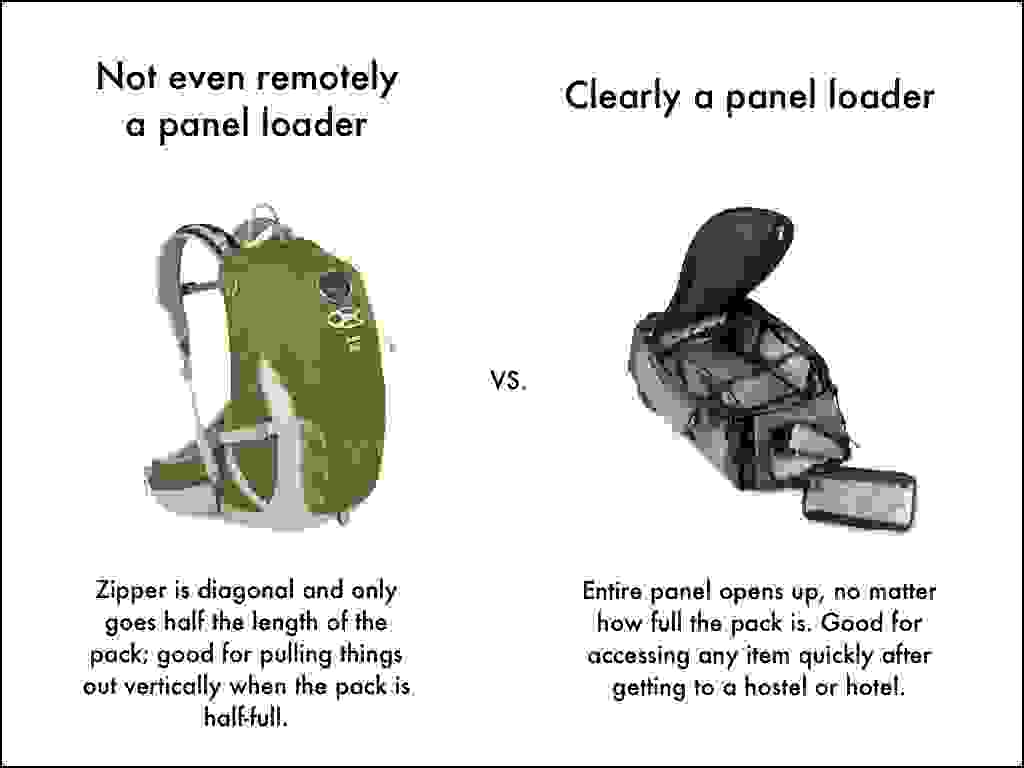
Again, half-panel loaders have their merits, but when I say I want a panel loader, I mean a real one.
And there’s a very clever hybrid solution found in the Kelty Redwing, which combines top loading with panel loading into a single zipper. Unfortunately, it was one of the most horrifically uncomfortable things I’ve ever experienced.
4. “Bridge” shoulder strap

I have no idea who thought up this incredibly stupid idea. I bet it went something like this:
“Hey guys! Let’s change something that’s been working perfectly for decades!”
“Um, why?”
“Because fuck you, that’s why!”
I’m referring to the so-called “haul loop” found at the top of the pack. You can use it to pick up the bag, hang it on something, or whatever. And a few companies have started making bags where the haul loop is integrated into the shoulder straps, forming a bridge between them.
This is a terrible idea. I mean really awful. It means you cannot adjust the pack to fit high up on your back. You are required to carry it lower on your back than you otherwise could, meaning if you like wearing it up high, you’re stuck with something digging into the back of your neck all day.
I’m pretty sure the designers consisted of incredibly large people who wear their packs low and never bothered checking with anyone else.
Oh, and the haul loop is smaller and thus harder to grab, and it’s vertically positioned rather than horizontally, so it’ll dig into your fingers more. Hooray!
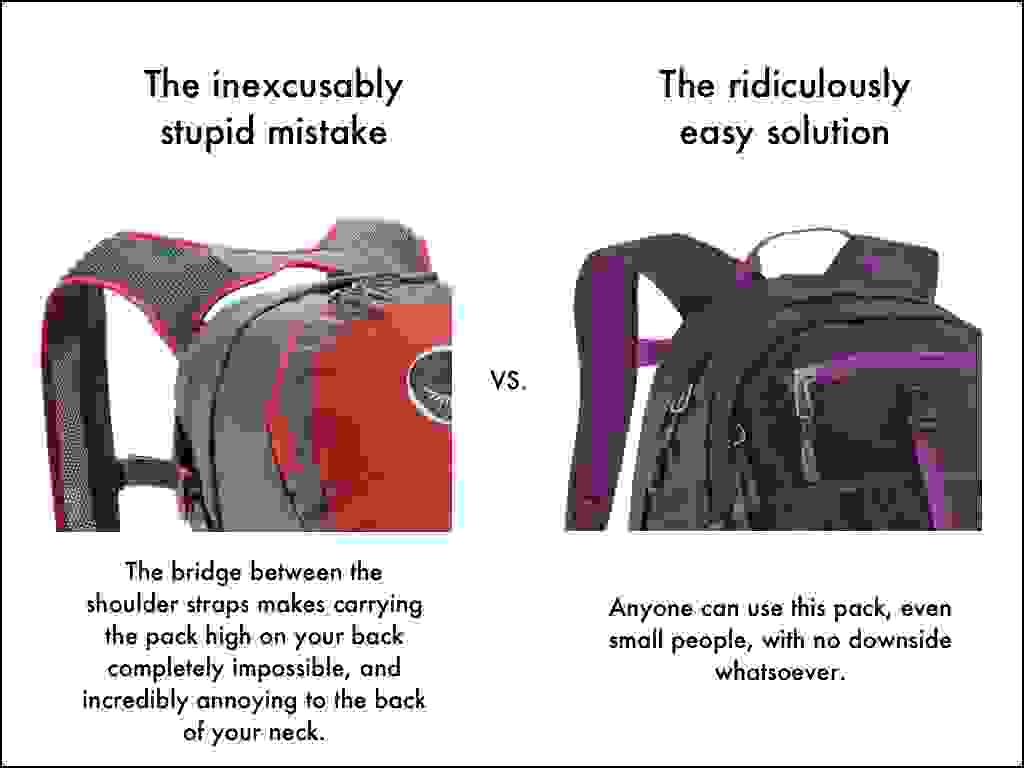
Seriously, how did no one say anything?
5. Centrally-placed vertical zipper
Okay, I know this one is kind of a reach, because it’s somewhat obscure. But it’s also dumb.
I’ve only seen this in a few places, and I think it’s supposed to be for maps, which are (usually) vertical pamphlets that can be slipped inside flat pockets with tall zippers. But tall, centrally-located vertical zippers are just incredibly stupid.
Firstly, it’s hard to put small things in there. It’s practically impossible seeing inside while trying to find them, and they might even fall out. And secondly, it’s also difficult putting large things in there. It seems like a decent place for a rain jacket, but the process consists of stuffing the jacket into the left half of the compartment, and then stuffing the rest into the right half. You literally cannot access the entire pocket all at once, because it’s just this tiny slit that’s somehow supposed to provide access to this massive pocket.
I had this sort of zipper on an old pack of mine, and I literally did not use the pocket. Ever. It just sat uselessly. It’s so difficult trying to take things in and out that I just didn’t bother anymore.
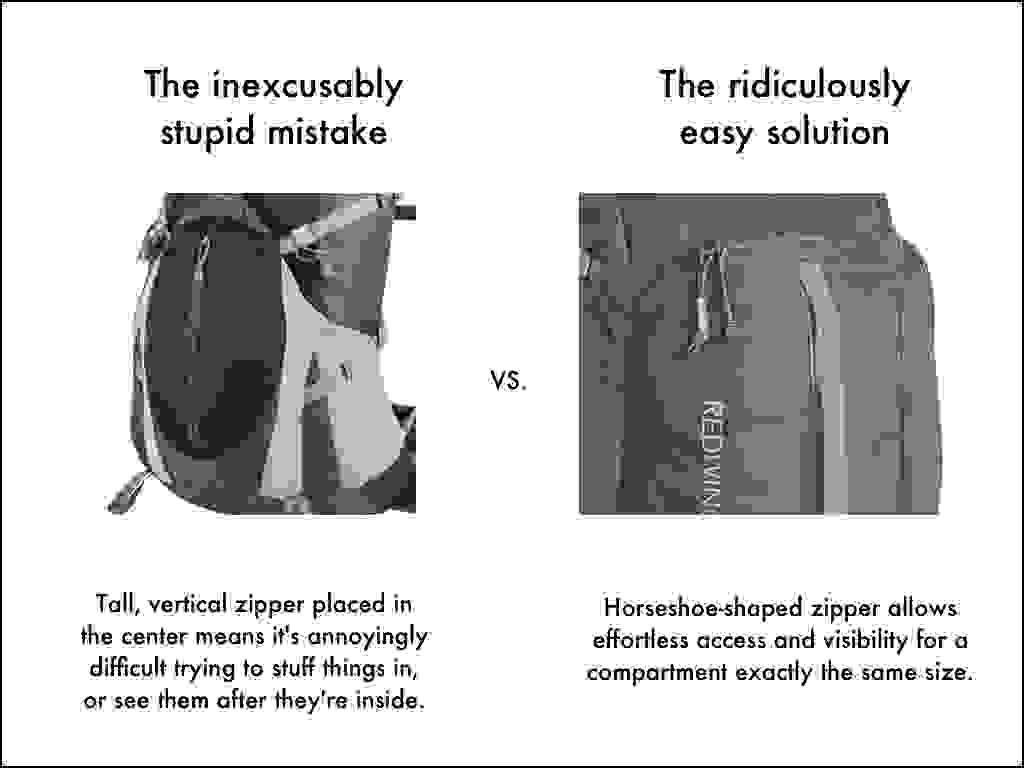
I really don’t get this one either. If you’re supposed to fit tall, flat papers into there, it would still work better to put the zipper literally anywhere else. Horizontally across the top, or vertically along the side. But, best of all, upside-down letter U. Done and done.
Backpack design error objective vs. subjective
Now I’ll readily admit that my particular needs may not be the same as those of someone else. But in the cases listed above, with the exception of the panel-loader vocabulary problem, the design choices are just objectively wrong. And, annoyingly, they are incredibly frequent. I really have no idea why they continue to exist.
I wonder if it’s simply that most people are more or less fine with a pack as long as it’s good, and they’ll live with the limitations as long as it holds up to serious use. I’d feel that way as well, but when I see design flaws, especially incredibly dumb ones, it just ruins my whole day.
A few more:
- Backpack manufacturers have apparently not realized that the load lifter straps (the small strap on top of the shoulder strap, that pulls the pack closer to your body) can be routed quite conveniently into hydration bladder port straps. Pretty much ever pack has a tiny strap, on the shoulder strap, where a hydration bladder hose is held in place. It’s also a great place to stick the load lifter straps so they don’t flail around annoyingly. The reason I think pack manufacturers haven’t realized this is that sometimes they’ll only put a strap on one side, instead of both.
- You know those hip stabilizer straps? Basically, it’s the small strap, on top of the hip strap, that pulls the pack closer to your body. It also forms a dangly thing that, if you have dual hip belt pockets with a slot where the dangly strap can go, can be kept out of the way. Once again, I don’t think pack manufacturers have quite realized this, because many of them give you only one hip belt pocket and the strap on the other side dangles annoyingly.
- When the base is rounded instead of flat, the pack falls over whenever you set it down. It’s incredibly annoying.
- If you have a top loader pack whose lid pocket attaches to a strap whose only connection point to the pack itself is at the very bottom of the pack, every time you unclip the buckle to open the pack, the strap will fall all the way to the ground. There could be something to prevent this, and it would be incredibly easy. I used dental floss. I’m sure they could do something a little more clever.
And you’ll notice that in many of the pictures shown above, the “bad” pack was an Osprey pack. And there’s a reason for that. Osprey make a million different packs, and plenty of people are happy with plenty of them, but…if I want to find a pack that’ll annoy the hell out of me, I know exactly where to go. Osprey is the absolute biggest culprit of tiny side pockets, and straps covering the side pocket anyway. Among other things.
I intend to continue complaining about these problems until I become such a thorn in the side of these companies that they are forced to acquiesce to my demands. Wish me luck!




I really enjoyed this article. I’m interested in backpacks for hiking rather than the travel type, but the same things apply. I especially bemoan the loss of zippered side pockets in order to get a certain “look.” I make my own packs for this and other reasons.
I noticed you referred to load lifter straps as “the small strap on top of the shoulder strap, that pulls the pack closer to your body.” Maybe just an oversight, but that’s not really what load lifters are designed to do. They actually transfer weight from shoulders to hipbelt, assuming the pack has a frame of some kind. Without a frame, they’re not of much use unless the pack is loaded completely full, making it somewhat rigid. With a frame, they allow you to adjust the ratio of weight on shoulders and hipbelt.
I enjoyed your pants rant as well. I finally bought the Mountain Hardwear “Piero 5-pocket pants,” which are basically nylon jeans. So far seem good for my uses. Not stretchy, but can’t afford the soft shell pants.
I agree with you on all of these points, the funny thing is I recognised almost all of the backpacks you’re referring to (have owned most of them, including the Ospreys and the REI pack with its awesome side pockets for water bottles… I’ve fit a massive thermos in that!) – I love my Ospreys, especially the Talon 22 for cycling because of the helmet lock, but the side pockets are completely useless even without the compression straps. Honestly, does anyone REALLY need compression straps on a 22L pack?? Small daypacks don’t need to be compressed. I also laugh at my husband’s Ayacucho with its stupid middle zip, it’s a good pack otherwise but I can’t believe anyone thought that was a good design idea. Good post :)
I know this is old, but those side pockets on backpacks like the osprey you pictured are for trekking poles or something similar. You can’t fit those inside a bag. Most of those bags are designed for backcountry. I realize your arguments for wanting a water bottle are still valid, but its useful to take into account the actual use of those side pockets. They still could be made expanding, but I’ve used the lashing straps more than I would ever need to put a bottle in there, especially when using the pack for its intended use (you know, what it was designed for).
Osprey’s stow-as-you-go trekking pole solution (or whatever they call it) is a good solution to get the trekking poles out of the way, and the standard method (placing them on the back) usually gets things out of the way too. I think splitting the gear up like that is a good idea, so I’d still rather have the side pockets work for water bottles as the primary item they need to hold.
The Osprey stow-on-the go system is a great idea, but it’s not intended as a method of carrying poles for any extended period of time, it’s just meant as a way to temporarily stash the poles under your arm to get your hands free without taking off your pack. This is very useful in steep terrain that requires a lot of scrambling, or maybe if you’re doing a lot of photography on the move.
For transporting the poles for any length of time, on most packs the best way to do this is to place them in the water bottle pockets, handle down and pointy end up, and use a side compression strap to hold them in place. On some packs with dual ice axe loops, you can use those instead, but many newer packs only have a single loop, and it’s difficult to fit two poles in one loop (especially if they have large baskets). Even on packs with dual ice axe loops, this method is often less secure than the water bottle pockets.
Also note that on the newer ‘Z’ style poles, neither the stow-and-go system nor the ice axe loops will work well if at all, and side pockets are really the best way to carry them.
Backpack designers and manufacturers are at the mercy of their clients. The bags are designed based on the client’s requirements and style. Sometimes the clients decide they want to be different… and this is what results in the functionality issues and flaws. We try our best to maintain uniqueness as well as functionality. We do love your honest opinion.
I get it–snazzy colors might sell more units to a certain type of customer, but if there’s an option somewhere in the lineup for the discerning customers who just reeeeaally want side pockets that can handle a water bottle…they can coexist among the same brand.
Yes, that’s true. It’s been over 30 years for us in the backpack & activewear manufacturing industry & in our experience of making custom backpacks in Vietnam, it’s usually the tough outdoor brands that place an emphasis on functionality. Whereas brands looking more into style & design opt for unique colors & backpack designs.
The bridged shoulder strap has a purpose, a specific one. It’s to both centralize the pack, usually a smaller daypack slightly lower on your back and allows you to look up while wearing a helmet. IE climbers and bicycle riders.
Put on a standard backpack, put on a large helmet, try to look up.
I have a couple backpacks like this I use for when I’m on a motorcycle.
I will now admit that this makes sense–but it still drives me crazy.
re: the bridged shoulder strap’s purpose
nah, I propose the true purpose is to stop women wearing it. I’m betting it goes something like this:
designer 1: we made a small backpack for men- you see, it sits low on the back-
designer 2: oh no, but that means.. that means a woman might be able to wear this pack if she shortens the shoulder straps enough!
designer 1: it’s ok, we already took precautions to prevent that. We made the shoulder straps quite long, and we made it so the sternum strap can’t be heightened by much
designer 2: that’s not enough! we need to be SURE!
designer 1: well.. we could merge the shoulder straps, a bridge if you will, so that women can’t wear it even though it’s a short torso length pack.
designer 2: that’s genius. we can sell it as a stability feature
—–
ok, but to be serious, this stupid thing prevents shorter people wearing the pack higher. Which disproportionately affects women because we’re not just shorter, but our torso’s are proportionally shorter- ie if you stand a man and a woman of the exact same height next to each other, the woman will have a shorter torso, requiring her to wear the pack higher. This ridiculous fail of a “feature” provides minor benefit, but excludes a lot of people from wearing the pack at all- if they don’t want it bouncing on their ass or digging into the back of their neck.
You are completely correct, and I run into this problem too. You know the worst part? It’s easy to fix. Cheap school backpacks have straps that nearly touch each other at the point where they’re sewn into the top of the pack, meaning that tightening the straps shortens the length, but also shrinks the side-to-side gap. Having shoulder straps emerge from the pack straight up means it’ll only fit a set of a shoulders of a specific width. Argh. Can’t figure out why they don’t know about that.
I found the perfect luggage backpack … and the manufactured stopped making it… instead apparently every effing person now travels with their giant laptops; or uses hiking gear; or plain doesn’t pack more than 20L??
If anyone out there is willing to sell me this oldie: http://www.bagit.com/nautica/details/05nautica/cinchsackseabag.html
Let me know! :( (FYI, that website company is out of business)
“I’m pretty sure the designers consisted of incredibly large people who wear their packs low and never bothered checking with anyone else.”
Welcome to the world of women. In the cycling world the attitude is called “shrink and pink” because the knee jerk reaction of designers is simply to scale kit down and make it in pink fabric. Always darned pink. And women are universally deemed to be delicate tiny little creatures so even if they make women’s specific kit it is made to fit sizes small, thin, and skinny. Rucksack hip belts are so short that even a normal person can’t do them up let alone someone who has a little spare fat. Thou shalt never have muscles, and if you are bigger than a ballet dancer you’re out of luck for much outdoor clothing. Even our feet are reckoned to be slender and tiny, so those of us with feet more suited to a hobbit are stuffed because men’s sizes which are several sizes wider start several sizes larger than most women’s feet. Straps and buckles are scaled down until they look as if they belong in a doll’s house and are impossible to operate with cold fingers. I’ve even seen supposed map pockets on waterproofs that were scaled in proportion to the rest of the jacket and as a result were smaller than a standard Ordnance Survey map. Doh!